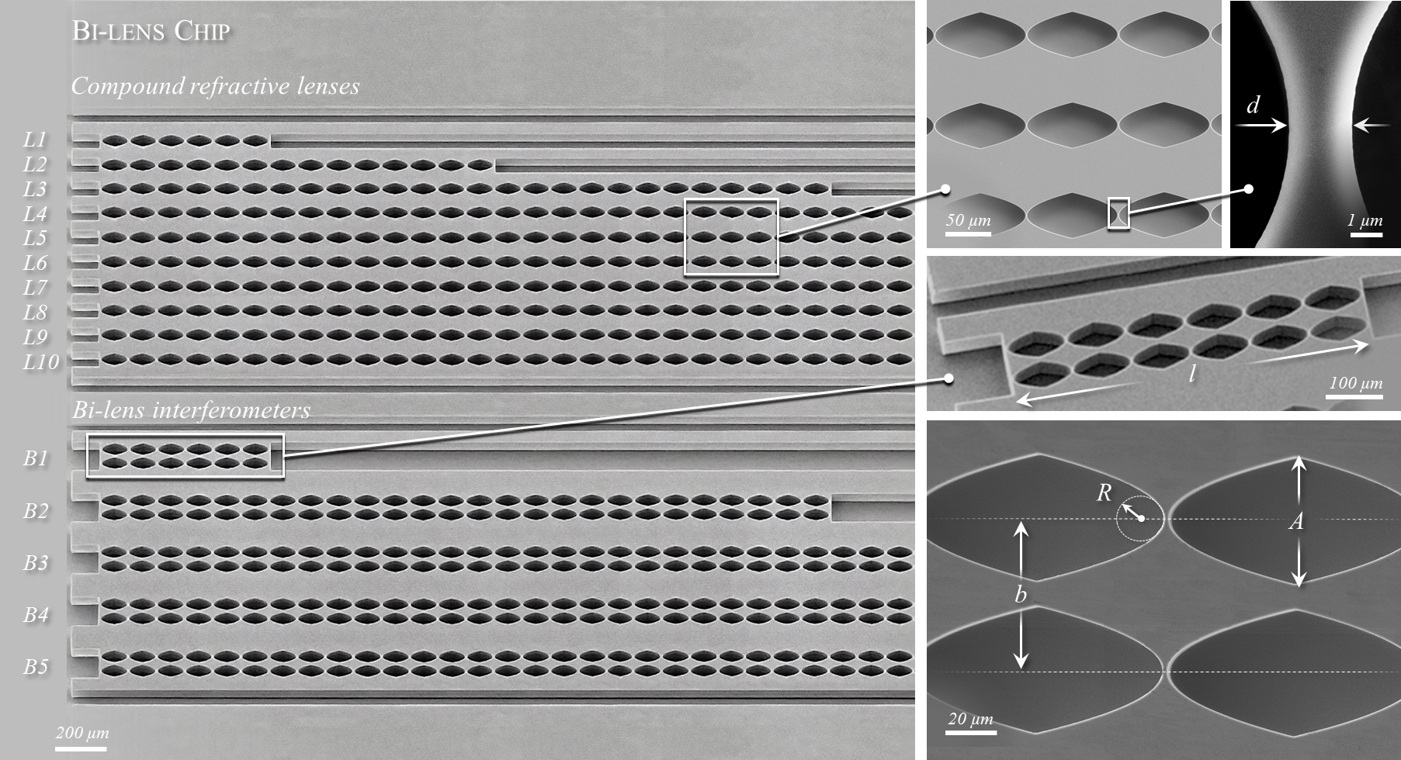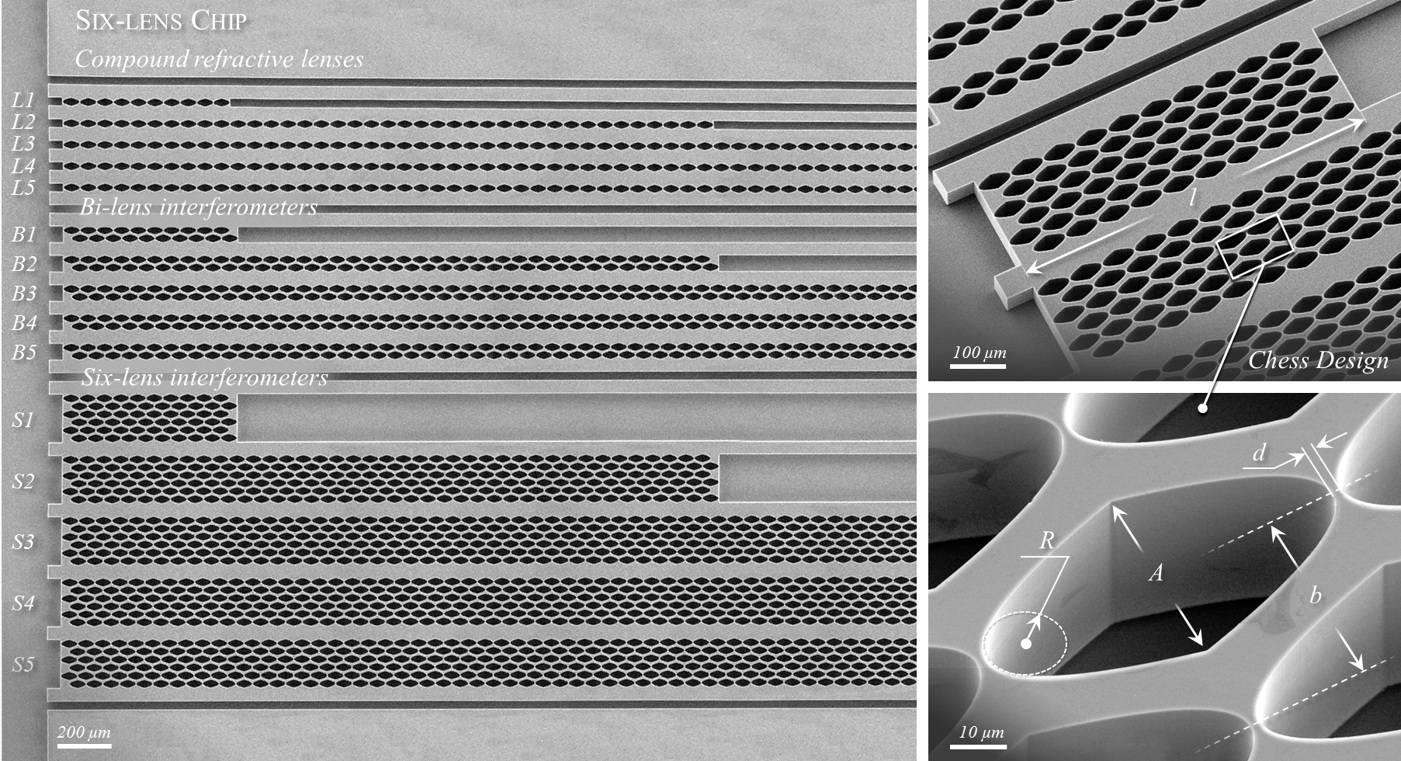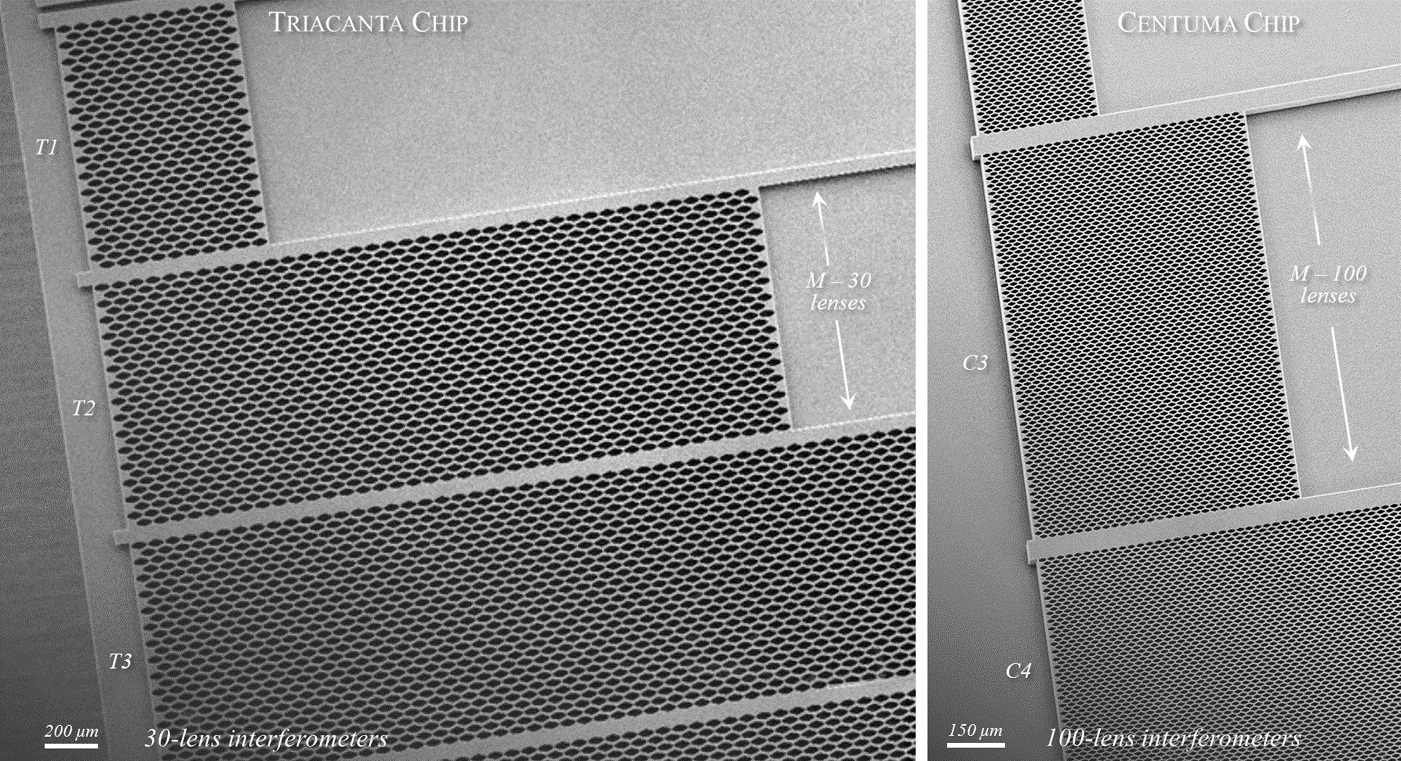X-ray silicon planar refractive optics
Planar parabolic lens structures are designed for hard X-ray micro- and nano-focusing, beam-shaping, and wavefront diagnostic. The structures are manufactured using the process involving optical or electron beam lithography and deep etching into the silicon. They represent sets of single compound refractive lenses, bi-lens, and multilens systems. There are four configurations of the structures implemented on individual silicon chips and optimized for the X-ray energy from 10 to 50 keV.
Bi-lens Chip consists of ten single compound refractive lenses (L1 – L10) and five bi-lens interferometers (B1 – B5). Each compound refractive lens has a different number N of biconcave parabolic elements with the physical aperture A of 50 µm. The curvature radius R in the apexes of the parabolic refractive surfaces is 6.25 µm. The web size d between biconcave refractive elements is 2 µm. The bi-lens interferometer represents two parallel compound refractive lenses, transversally separated by a distance b equal to 60 µm.
| Bi-lens Chip | L1 | L2 | L3 | L4 | L5 | L6 | L7 | L8 | L9 | L10 | B1 | B2 | B3 | B4 | B5 | |
| Number of lenses N | 6 | 14 | 26 | 40 | 58 | 80 | 104 | 132 | 162 | 196 | 6 | 26 | 58 | 104 | 162 | |
| Lens length l, um | 614 | 1430 | 2654 | 4082 | 5918 | 8162 | 10610 | 13466 | 16526 | 19994 | 614 | 2654 | 5918 | 10610 | 16526 | |
Six-lens Chip consists of five single compound refractive lenses (L1 – L5), five bi-lens interferometers (B1 – B5), and five six-lens interferometers (S1 – S5). The physical aperture A of the lenses is 30 µm, curvature radius R is 3.75 µm and web size d is 2 µm. The bi-lens and six-lens interferometers have specially developed chess designs, in which adjacent compound refractive lenses are displaced relative to each other by half of its biconcave parabolic elements to achieve zero space between them.
| Six-lens Chip | L1 | L2 | L3 | L4 | L5 | B1 | B2 | B3 | B4 | B5 | S1 | S2 | S3 | S4 | S5 | |
| Number of lenses N | 10 | 39 | 87 | 156 | 243 | 10 | 39 | 87 | 156 | 243 | 10 | 39 | 87 | 156 | 243 | |
| Lens length l, um | 622 | 2420 | 5396 | 9674 | 15068 | 652 | 2450 | 5426 | 9704 | 15098 | 652 | 2450 | 5426 | 9704 | 15098 | |
Triacanta Chip consists of five single compound refractive lenses (L1 – L5), five bi-lens interferometers (B1 – B5), and five 30-lens interferometers (T1 – T5). The structural parameters of the lens systems are the same as the Six-lens Chip.
| Triacanta Chip | L1 | L2 | L3 | L4 | L5 | B1 | B2 | B3 | B4 | B5 | T1 | T2 | T3 | T4 | T5 | |
| Number of lenses N | 10 | 39 | 87 | 156 | 243 | 10 | 39 | 87 | 156 | 243 | 10 | 39 | 87 | 156 | 243 | |
| Lens length l, um | 622 | 2420 | 5396 | 9674 | 15068 | 652 | 2450 | 5426 | 9704 | 15098 | 652 | 2450 | 5426 | 9704 | 15098 | |
Centuma Chip consists of five single compound refractive lenses (L1 – L5), five bi-lens interferometers (B1 – B5), and five 100-lens interferometers (C1 – C5). The physical aperture A of the lenses is 10 µm, curvature radius R is 1.25 µm and web size d is 2 µm. The interferometers have chess designs.
| Centuma Chip | L1 | L2 | L3 | L4 | L5 | B1 | B2 | B3 | B4 | B5 | C1 | C2 | C3 | C4 | C5 | |
| Number of lenses N | 3 | 13 | 29 | 52 | 81 | 3 | 13 | 29 | 52 | 81 | 3 | 13 | 29 | 52 | 81 | |
| Lens length l, um | 68 | 288 | 640 | 1146 | 1784 | 68 | 288 | 640 | 1146 | 1784 | 68 | 288 | 640 | 1146 | 1784 | |
Papers
- Snigirev, A., Snigireva, I., Kohn, V., Yunkin, V., Kuznetsov, S., Grigoriev, M.B., Roth, T., Vaughan, G., & Detlefs, C. (2009). X-ray nanointerferometer based on si refractive bilenses. Physical review letters, 103(6), 064801.
- Zverev, D., Snigireva, I., Kohn, V., Kuznetsov, S., Yunkin, V., & Snigirev, A. (2020). X-ray phase-sensitive imaging using a bilens interferometer based on refractive optics. Optics Express, 28(15), 21856-21868.
- Snigirev, A., Snigireva, I., Lyubomirskiy, M., Kohn, V., Yunkin, V., & Kuznetsov, S. (2014). X-ray multilens interferometer based on Si refractive lenses. Optics express, 22(21), 25842-25852.
- Lyubomirskiy, M., Snigireva, I., Kohn, V., Kuznetsov, S., Yunkin, V., Vaughan, G., & Snigirev, A. (2016). 30-Lens interferometer for high-energy X-rays. Journal of synchrotron radiation, 23(5), 1104-1109.
- Zverev, D., Snigireva, I., Sorokovikov, M., Yunkin, V., Kuznetsov, S., & Snigirev, A. (2021). Coherent X-ray beam expander based on a multilens interferometer. Optics Express, 29(22), 35038-35053.



